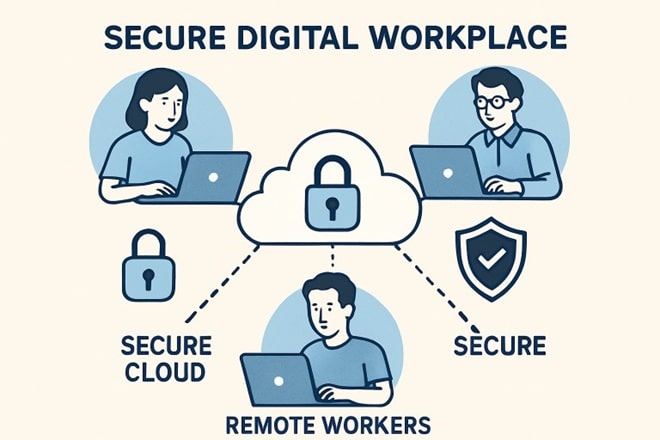Key Takeaways
- Implementing Zero Trust Architecture (ZTA) enhances security by requiring continuous verification of users and devices.
- Integrating cloud-native security solutions ensures scalable and effective protection for cloud environments.
- Utilizing Endpoint Detection and Response (EDR) tools provides real-time monitoring and rapid incident response.
- Regular security awareness training strengthens the human firewall against cyber threats.
- Adopting Multi-Factor Authentication (MFA) and biometrics reinforces access control measures.
As the boundaries of the modern workplace evolve, so do the complexities of digital security. Today’s enterprises must balance flexible connectivity for remote and hybrid teams with robust protection against an ever-growing spectrum of cyber threats. Technologies such as SASE by Versa now play a pivotal role in unifying secure access with streamlined network performance, ensuring seamless and safe operations for digital-first businesses. Employing a layered and comprehensive security approach is now critical as sensitive data and business processes leave traditional office perimeters. Both policy and technology must adapt to keep pace with the changes, requiring constant vigilance and innovation to outmaneuver sophisticated attackers intent on exploiting vulnerabilities in the digital workspace. Organizations are rethinking legacy solutions to deploy modern defenses: from continuous user verification to cloud-native controls that accommodate distributed workforces, and empowering employees as the first line of defense. Each strategy underpins a secure, agile environment primed for productivity and resilience in the face of digital disruption. Strategic investments in people, processes, and technology will dictate how successful organizations are at minimizing risk while maximizing business opportunities in digitally connected environments.
Zero Trust Architecture: A New Standard for Network Defense
Zero Trust Architecture (ZTA) has emerged as an essential strategy in the fight against sophisticated cybercriminals and insider threats. Unlike traditional perimeter-based security models, ZTA assumes no user or device, inside or outside the network, is trustworthy by default. Every access request, regardless of context, is subject to strict identity verification, robust authentication, and granular authorization. Implementing Zero Trust can dramatically minimize attack surfaces, limit damage from breaches, and provide detailed visibility over network activity. To effectively implement ZTA, organizations should leverage micro-segmentation, monitor for anomalous behavior, and apply the principle of least privilege. A mature Zero Trust framework includes regular access reviews, device health validation, and identity and access management system integration.
Cloud-Native Security Solutions for an Evolving Infrastructure
As businesses accelerate digital transformation and cloud adoption, the need for cloud-native security becomes paramount. Platforms designed for cloud such as Cloud Security Posture Management (CSPM) and Cloud Workload Protection Platforms (CWPP) offer automated compliance monitoring, vulnerability detection, and runtime protection. Cloud-native security tools span multi-cloud environments, empowering organizations to safeguard assets and workloads wherever they reside. Ensuring secure cloud connectivity also requires secure access solutions, encryption practices, and robust policy enforcement at each layer of the cloud stack. Leveraging cloud-native security means security teams can proactively identify configuration drift and remediation risks and ensure continuous compliance as environments scale.
Endpoint Detection and Response (EDR): Real-Time Visibility
With an expanding attack surface created by bring-your-own-device (BYOD) and remote work, endpoints have become primary targets for cybercriminals. Endpoint Detection and Response (EDR) solutions are vital for monitoring, detecting, and responding to threats in real time at the device level. These platforms gather behavioral data, analyze activity, and trigger rapid response actions to isolate or contain threats before they propagate. Modern EDR platforms provide deep visibility into endpoint activities, leveraging machine learning and automation to minimize response times and reduce alert fatigue for security teams. Regular review and tuning of endpoint policies further ensure that all devices comply with organizational security standards and industry regulations.
Security Awareness Training: Strengthening the Human Firewall
Technology alone cannot prevent every security incident. As the human element remains one of the weakest links in cybersecurity, ongoing security awareness training is critical. Employees must recognize and avoid phishing attempts, practice safe password management, and adhere to company security protocols. Effective programs use a mix of live simulations, e-learning modules, and phishing drills to maintain engagement and reinforce key lessons. According to IBM’s Cost of a Data Breach Report, organizations investing in employee awareness enjoy lower breach costs and improved overall risk posture.
Multi-Factor Authentication (MFA) and Biometrics: Reinventing Access Control
The era of relying solely on passwords for security is over. Multi-factor authentication (MFA) dramatically reduces the risk of unauthorized access by requiring users to provide two or more forms of verification such as a one-time code, push notification, or biometric scan before access is granted. Biometrics, encompassing fingerprint, facial, and voice recognition, offer additional frictionless but strong authentication methods. Integrating MFA and biometrics as default security protocols safeguards against credential theft, phishing, and brute-force attacks. Today, these technologies represent best practices for accessing sensitive systems, remote networks, and cloud environments.
Supporting Remote Teams with Secure Frameworks
Remote and hybrid workforces pose new security challenges that traditional security models cannot adequately address. Frameworks such as the National Institute of Standards and Technology (NIST Cybersecurity Framework) offer practical guidance for managing digital risk. These frameworks outline best practices for access control, encryption, security event monitoring, and continuous policy improvement across distributed environments. Implementing these frameworks ensures alignment with regulatory requirements, accelerates incident response, and fosters a culture of continuous security improvement. This approach allows organizations to empower remote teams with the tools and policies needed to operate safely from any location. Organizations that employ these layered strategies will realize a future-ready digital workplace one that maximizes productivity through seamless connectivity while maintaining robust protection against a dynamic threat landscape.

